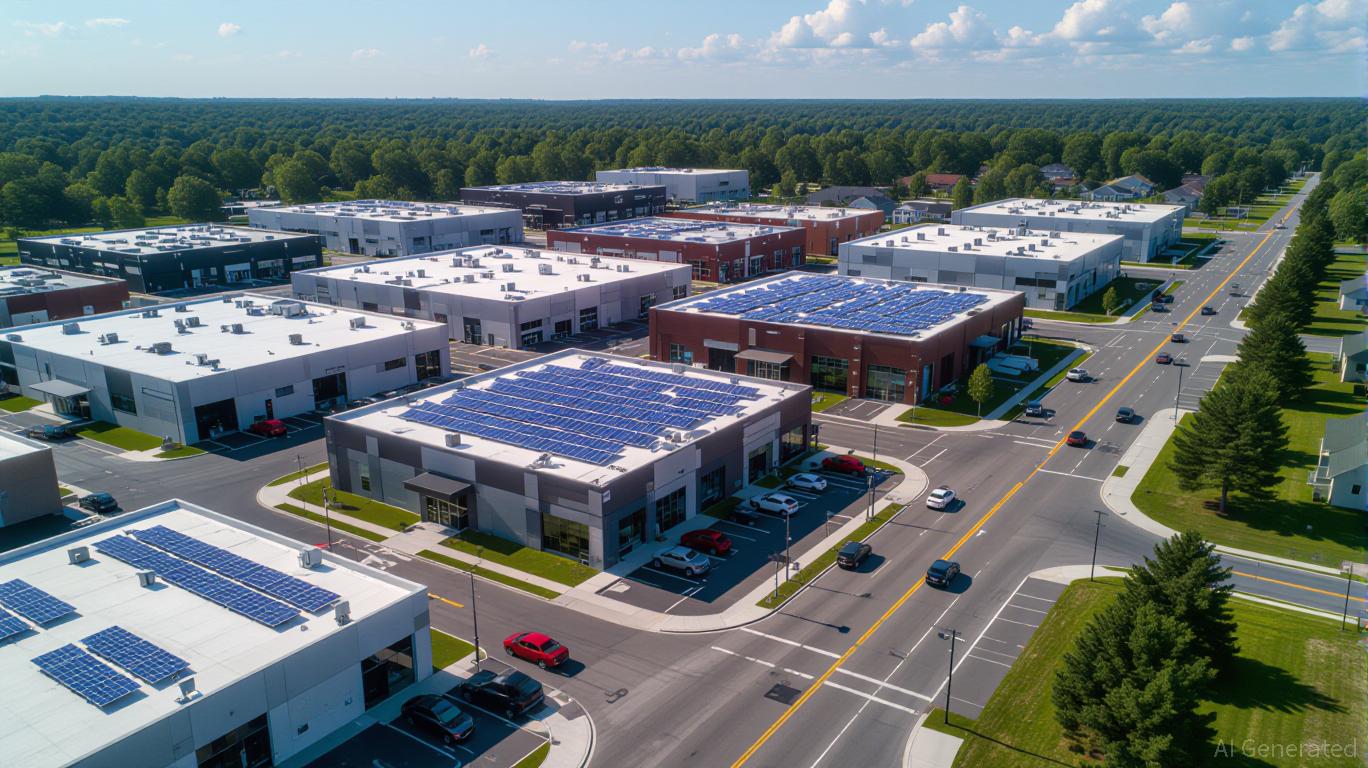Municipal Infrastructure Driving Economic Expansion and Real Estate Development: A Case Analysis of Webster, NY
- Webster , NY's $9.8M FAST NY grant transformed a 300-acre brownfield into a competitive industrial hub with upgraded infrastructure, attracting $650M private investments like the fairlife® dairy plant. - Strategic infrastructure spending reduced industrial vacancy rates to 2% (vs. 7.3% national average) and drove 10.1% residential property value growth, creating a self-reinforcing economic cycle. - Public-private partnerships, including brownfield remediation and mixed-use redevelopment, diversified Webs
Webster, NY: A Blueprint for Economic Renewal Through Infrastructure Investment
The revitalization of Webster, New York, stands as a powerful example of how thoughtful public investment in infrastructure can spark growth in commercial real estate, drive industrial expansion, and rejuvenate local economies. By exploring the impact of a $9.8 million FAST NY grant and the transformation of the former Xerox campus, we see a roadmap for investors interested in regions where public-private collaboration paves the way for sustainable, long-term gains.
The Power of Infrastructure in Economic Growth
Infrastructure improvements go far beyond basic repairs—they lay the groundwork for business success. In Webster, the FAST NY grant enabled vital upgrades to a 300-acre brownfield, including modernized electrical grids, increased sewer capacity, and redesigned roadways. These enhancements have positioned Webster to compete with established industrial centers in the Sun Belt and Midwest, making it an attractive destination for logistics and manufacturing companies.
Governor Kathy Hochul’s initiative to develop “shovel-ready” sites is clearly visible in Webster’s progress. The area has already drawn major private investments, such as the $650 million fairlife® dairy facility, expected to generate 250 new jobs. This demonstrates how infrastructure funding can attract advanced manufacturing and renewable energy businesses. By 2025, the site is projected to offer over one million square feet of industrial space, highlighting the scalability of such development strategies.
Commercial Real Estate: Vacancy and Value on the Rise

The benefits of infrastructure-led development are clearly reflected in Webster’s commercial property market. By 2025, industrial properties in the town are expected to have a vacancy rate of just 2%, a sharp contrast to the national average of 7.3%. This low vacancy rate signals strong demand from logistics and manufacturing firms, attracted by Webster’s access to Buffalo’s port and rail networks, competitive energy costs, and a skilled labor force.
Residential real estate is also thriving, with home values rising by 10.1% over the past year. This surge is directly linked to the town’s strategic infrastructure investments, which not only draw businesses but also improve quality of life for residents. The resulting cycle—where commercial growth fuels residential demand, and vice versa—creates a robust foundation for ongoing prosperity.
Strategic Collaboration: Public and Private Sectors in Sync
Webster’s achievements are rooted in strong cooperation between public agencies and private investors. The FAST NY grant played a crucial role in reducing risk for private developers by covering the initial costs of land remediation and infrastructure upgrades. This partnership is especially important in regions like Upstate New York, where historic underinvestment has slowed economic progress.
The demolition of the 600 Ridge Road property, part of the West Webster Hamlet Revitalization Project, is another example of this approach. By converting underused land into mixed-use developments, Webster is building a diverse economic base that is less vulnerable to industry-specific downturns. These projects foster vibrant communities where innovation, manufacturing, and residential life can flourish together.
Investor Takeaways: Recognizing Opportunity in Infrastructure
For investors, Webster’s story underscores the value of targeting areas where infrastructure spending is driving meaningful change. The town’s success in attracting a $650 million dairy plant—an investment unlikely to materialize without robust infrastructure—shows the powerful ripple effects of strategic public funding.
Moreover, the data reveals that these projects deliver benefits beyond immediate job creation. The 10.1% increase in home values and the anticipated one million square feet of new industrial space demonstrate the compounding returns of infrastructure-driven development. Investors in commercial, industrial, or residential properties in Webster are well-positioned to benefit from this virtuous cycle of growth.
Conclusion: Infrastructure as a Catalyst for Lasting Value
Webster, NY, exemplifies how cities that prioritize infrastructure as a driver of economic and real estate development can achieve remarkable results. The FAST NY grant and the redevelopment of the Xerox campus show that targeted public investment, combined with private sector initiative, can transform neglected sites into engines of prosperity. For investors, the message is clear: regions that treat infrastructure as a strategic asset offer fertile ground for enduring value creation.
Disclaimer: The content of this article solely reflects the author's opinion and does not represent the platform in any capacity. This article is not intended to serve as a reference for making investment decisions.
You may also like
Webster, NY: A Center for Revitalization and Growth Fueled by Infrastructure
- Webster , NY, leverages public-private partnerships to drive real estate and industrial growth through $4.5M downtown revitalization and $9.8M infrastructure upgrades. - Brownfield Opportunity Area designations and waterfront projects unlock underused land, attracting $650M fairlife® facility and mixed-use developments with state-funded remediation. - Strategic infrastructure investments at Xerox campus and Sandbar Waterfront enhance industrial readiness and property values, creating scalable opportuniti

Switzerland Postpones Crypto Tax Data Exchange to Meet Technological and International Requirements
- Switzerland delays crypto tax data sharing until 2027, aligning with global regulatory reevaluations amid evolving tech and market dynamics. - SGS acquires Australia's Information Quality to boost digital revenue, reflecting Swiss firms' expansion into tech-driven compliance solutions. - Canada's Alberta oil sands policy shift highlights governments prioritizing economic growth over strict climate regulations, mirroring Switzerland's approach. - BridgeBio's precision medicine and Aires' EMF solutions dem

Switzerland's Focus on Privacy Conflicts with International Efforts for Crypto Taxation
- Switzerland delays crypto tax data sharing with international partners until 2027, contrasting with global regulatory efforts to close offshore loopholes. - The U.S. advances implementation of the OECD's CARF framework, aiming to automate reporting on foreign crypto accounts by 2029. - CARF requires foreign exchanges to report U.S. account details, mirroring traditional tax standards and targeting crypto tax evasion. - Switzerland's privacy-focused stance highlights tensions between financial confidentia

Zcash News Update: Reliance Shifts Entirely to Zcash, Citing Privacy and Regulatory Alignment
- Reliance Global Group, a Nasdaq-listed fintech firm, shifted its entire crypto portfolio to Zcash (ZEC), divesting Bitcoin , Ethereum , and other major coins. - The strategic pivot, announced November 25, prioritizes Zcash's privacy-focused zk-SNARKs technology for institutional compliance and selective data disclosure. - Zcash's 1,200% 90-day price surge and Grayscale's ETF filing highlight growing institutional interest in privacy-centric assets. - The move reflects broader crypto industry trends towar